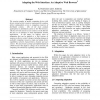1231 search results - page 149 / 247 » User Interfaces for Mobile Augmented Reality Systems |
HAPTICS
2003
IEEE
14 years 2 months ago
2003
IEEE
Haptic interfaces enable us to interact with virtual objects by sensing our actions and communicating them to a virtual environment. A haptic interface with force feedback capabil...
CHI
2006
ACM
14 years 9 months ago
2006
ACM
Many augmented reality (AR) applications which overlay computer graphics on a real image have been developed. One of the limitations of such applications is that a user has to con...
ISWC
1998
IEEE
14 years 1 months ago
1998
IEEE
Wearable computers provide constant access to computing and communications resources. In this paper we describe how the computing power of wearables can be used to provide spatial...
AUIC
2001
IEEE
14 years 18 days ago
2001
IEEE
The growing number of mobile computing devices with diverse characteristics creates a requirement for seamless (device independent) access to computing resources of distributed sy...
MUM
2009
ACM
14 years 3 months ago
2009
ACM
In this paper we introduce WiMo, a location-based social networking tool that enables users to share and store their emotional feelings about places. WiMo creates a mobile social ...

